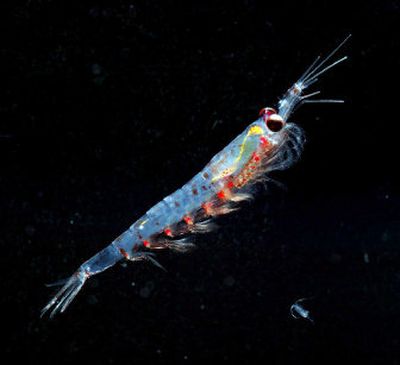Advisory council backs krill fishing ban

SEATTLE – They’re tiny but live in massive underwater swarms. They make salmon flesh red. Humpback whales eat them by the ton.
They are krill – euphausiids – shrimplike creatures that scientists say are the ocean’s fundamental food source.
But despite their huge volumes, scientists worry that a growth in aquaculture may result in a viable krill market off the West Coast to feed captive fish.
Those fears were allayed Wednesday when fishery managers, meeting this week in Seattle, moved to prohibit krill fishing off Pacific shores.
The Pacific Fishery Management Council, an advisory board to the National Marine Fisheries Service, approved the krill harvest ban. The recommendation now must be approved by the agency.
Concern about krill surfaced in 2004 when managers of the Monterey Bay, Gulf of the Farallones Island and Cordell Banks National Marine Sanctuaries in California raised a red flag.
Krill are a vital part of the aquatic food chain, eaten by everything from fish and seabirds to baleen whales.
“Our concern is that a targeted krill fishery would threaten the health of the region’s fishing economy and culture,” said Rachel Saunders of Monterey Bay sanctuary.
Fishermen, environmental groups and scientists supported the council’s actions. Krill fishing is banned in state and federal waters off Alaska.
One lone fisherman, Ryan Kapp of Bellingham, said he thought it would have been “neat” to try out krill fishing on a small scale off the coast of Oregon and Washington.
He said had been krill fishing in Canadian waters, where limited harvests are allowed.
But Kapp was a lone voice in opposition. About 6,000 comments filed with the council urged the ban.
A federal ban would fill a loophole that exists in state law. California, Oregon and Washington prohibit krill harvesting for local fishermen. But fishermen from other states could harvest krill in the area and then land the catch in their home ports. And with no federal ban until now, foreign fisherman also could have fished for krill off the West Coast.
Most krill fishing is done with huge trawlers in the Antarctic. The vessels travel thousands of miles and spend months at sea, said Roger Hewitt, a biologist with NOAA Fisheries.
He said about 100,000 tons of krill are caught there annually. Smaller catches are made off Japan and British Columbia. Krill is a fragile catch that must be immediately frozen once brought aboard, Hewitt said.
The market for krill may be on the rise, officials said. Krill is eaten in Japan and Russia and its oil is sold in U.S. health-food markets as an anti-aging remedy.
But mostly, krill is used to feed fish, from home aquariums to fish farms. Fed to farm-raised salmon, krill give the fish the reddish hue found in their wild counterparts.
Schools of krill, miles long and wide, swarm on deep underwater cliffs off the West Coast and are easy prey for marine life such as blue whales.
The concentrations also make krill an easy catch for human fishers, who scoop them up with giant, fine-meshed nets.
“You could wipe out a krill patch pretty quickly,” said Don Croll, a biology professor at the University of California at Santa Cruz.
Krill also are vulnerable to ocean conditions, Hewitt said. When cold water is drawn down from the north, krill populations thrive.
But when the trend is reversed, in so-called El Niño years, the krill suffer – and the impact is felt up the food chain. This occurred last year, and several seabirds died as a result.
Now that the council has proposed a federal ban, Ben Enticknap, a spokesman for the environmental group Oceana, said they’ll move to extend the ban to all U.S. waters.